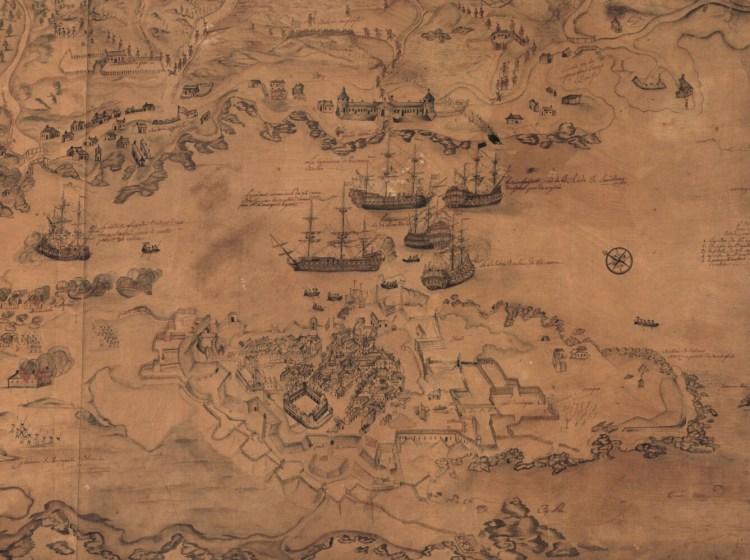June 16, 1745: New England Colonial fighters under the command of William Pepperell (1696-1759), a wealthy Kittery merchant, seize control of the French fortress of Louisbourg after a six-week siege during King George’s War. One-third of the attacking Colonials are from Maine.

The fortress stands on Cape Breton Island. The island remained under French control under the terms of the Treaty of Utrecht, which ended Queen Anne’s War (1702-1713). The French quickly built the fort, and it later served as a staging area for French raids against English settlements.
After the New Englanders’ 1745 conquest of the fort, Pepperell is made a baronet in recognition of his victory, becoming the first English colonist to be elevated to the ranks of nobility.
At the end of King George’s War, the 1748 Treaty of Aix-la-Chappelle restores the fortress to French control, but the French lose it permanently after the 1756-1763 French and Indian War.
Today, Cape Breton Island is part of the Canadian province of Nova Scotia. The fortress at Louisbourg, once destroyed, has been partially reconstructed. Parks Canada historical interpreters in clothing resembling that of the 18th century play the roles of French fort inhabitants when they tell visitors about the fortress’s history.
June 16, 1987: About 1,250 employees walk off the job at the International Paper mill in Jay, beginning an ultimately unsuccessful 16-month strike that results in permanent replacement of the striking workers.
The strike begins after the rejection by Local 14 of the United Paperworkers International Union of a labor contract offer from IP, which was seeking major concessions at a time when its financial condition was sound. IP – the world’s largest paper company and the nation’s largest landowner – then spends lavishly on a public relations campaign to discredit the union. The outgunned workers, many of whom live in Jay or neighboring Livermore Falls, maintain a 24-hour-per-day picket line outside the mill and conduct a series of well-attended and well-publicized rallies, including a picket line at the governor’s mansion in Augusta.
As the strike persists, IP hires replacement workers who become the targets of vandalism and threats of violence. The rift draws national attention and divides the region, causing people who once were close friends in the Androscoggin River towns to become bitter adversaries.
“They threw a 2-by-4 through my windshield the first day I drove my truck into the mill, but it’s been worth it,” replacement worker Jay Clement tells the Los Angeles Times. “My wife’s behind me 100 percent and the kids think it’s great. I can buy them things I could never afford before.”
Around the state, the dispute arouses little sympathy either for strikers, who were earning wages far greater than average in Maine; or the company, which is seen as arrogant.
The union’s national office finally capitulates in October 1988, offering to tell its members to return to work with no conditions attached. Embittered local members, feeling betrayed by union leaders, are demoralized further when the company, having found and trained enough replacements, announces it has no jobs for them.
“The strike helped to convince organized labor that the traditional strike weapon was ineffective, led to a major but unsuccessful effort to amend the National Labor Relations Act, and signaled the demise of adversarial collective bargaining that had dominated labor relations since World War II,” University of Texas Law School professor Julius Getman concludes in his 1998 book on the strike.
Labor organizer Peter Kellman, hired by the Maine AFL-CIO to work with Local 14 during the strike, reflects on it in his own book, published in 2004. Kellman describes labor unions as being fairly democratic at the local level, but structured nationally in a way that discourages members’ participation and often produces results that don’t align with local members’ interests.
“The result is that only a handful of people decide who speaks for labor in this country. And that handful is generally pretty far removed from the everyday life and pressures of the actual rank-and-file union members,” Kellman writes.
Two years after the strike’s end, about 100 former millworkers have been rehired at the mill. More than 1,000 have not.
Despite severe contractions in the paper industry, the mill remains in production in the early 21st century. CMP Holdings LLC, a subsidiary of Ohio-based Verso Corp., buys the Jay mill from International Paper in 2006. Verso sells it to Pennsylvania-based Pixelle Specialty Solutions LLC in February 2020 as part of a $400 million deal that also includes a mill in Stevens Point, Wisconsin.
The Jay mill, established in 1885, employs about 500 workers today.
Presented by:

Joseph Owen is an author, retired newspaper editor and board member of the Kennebec Historical Society. Owen’s book, “This Day in Maine,” can be ordered at islandportpress.com. To get a signed copy use promo code signedbyjoe at checkout. Joe can be contacted at: jowen@mainetoday.com.
Send questions/comments to the editors.



Success. Please wait for the page to reload. If the page does not reload within 5 seconds, please refresh the page.
Enter your email and password to access comments.
Hi, to comment on stories you must . This profile is in addition to your subscription and website login.
Already have a commenting profile? .
Invalid username/password.
Please check your email to confirm and complete your registration.
Only subscribers are eligible to post comments. Please subscribe or login first for digital access. Here’s why.
Use the form below to reset your password. When you've submitted your account email, we will send an email with a reset code.